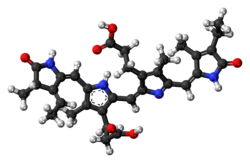Phycocyanobilin

| |

| |
| Names | |
|---|---|
| IUPAC name
3-[(2Z,5E)-2-[[3-(2-carboxyethyl)-5-[(Z)-[(3R,4R)-3-ethyl-4-methyl-5-oxopyrrolidin-2-ylidene]methyl]-4-methyl-1H-pyrrol-2-yl]methylidene]-5-[(4-ethyl-3-methyl-5-oxopyrrol-2-yl)methylidene]-4-methylpyrrol-3-yl]propanoic acid
| |
| Identifiers | |
3D model (
JSmol ) |
|
| 4285356 | |
| ChEBI | |
| ChemSpider | |
PubChem CID
|
|
| UNII | |
| |
| |
| Properties | |
| C33H38N4O6 | |
| Molar mass | 586.69 g/mol |
Except where otherwise noted, data are given for materials in their standard state (at 25 °C [77 °F], 100 kPa).
| |
Phycocyanobilin is a blue
Phycocyanobilin (PCB), has the ability to bind to human serum albumin (HSA), protein found mainly in the blood of humans. This PCB-HCA complex benefits the structure of HSA, increasing the thermal stability of HSA, as well as increasing its ability to prevent against proteolytic activity of other proteins.[1]
Biosynthetic Pathway

The biosynthetic pathway of phycocyanobilin begins with 5-Aminolevulinic acid (5-ALA).[2] Two molecules of 5-ALA undergo a condensation reaction catalyzed by Porphobilinogen (PBG) Synthase to yield a molecule of Porphobilinogen (PBG) (not shown).[3] Four molecules of PBG are polymerized into a linear tetrapyrrole by Porphobilinogen deaminase. This reaction releases four ammonia molecules in the process. Completion of the tetrapyrrole is performed by Uroporphyrinogen III synthase which results in the macrocyclic Uroporphyrinogen III. Uroporphyrinogen III is then converted to a Heme by a Uroporphyrinogen III decarboxylase. The heme molecule is converted to Biliverdin IX α. Biliverdin is then finally reduced to Phycocyanobilin (PCB) by the Phycocyanin Ferredoxin Oxidoreductase PcyA. Literature circa 1989 includes phytochromobilin as an intermediate in this final conversion.[2]
References
- PMID 27959940.
- ^ from the original on 2024-03-20. Retrieved 2023-07-10.
- ISBN 9780444632814, archivedfrom the original on 2024-03-20, retrieved 2023-06-08
Further reading
- Cole WJ, Chapman DJ, Siegelman HW (1967). "Structure of phycocyanobilin". ISSN 0002-7863.
